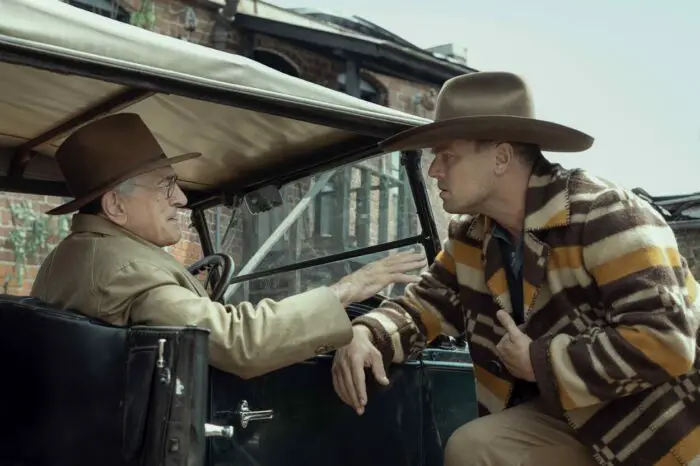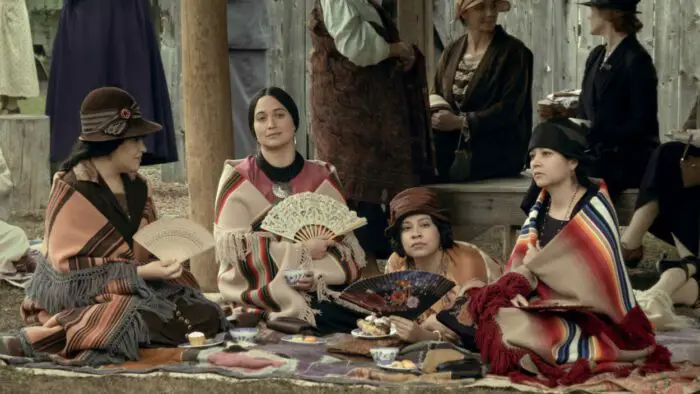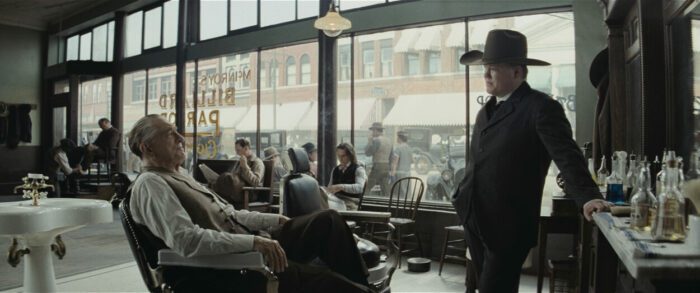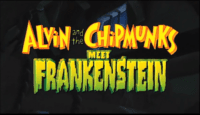“Can you find the wolves in this picture?”
Ernest Burkhart (Leonardo DiCaprio) reads this line in a book while reading up on the Osage in Martin Scorsese‘s outstanding and riveting Killers of the Flower Moon. It’s a chilling line that I can’t seem to shake off. Early on in the movie, we find out who the hungry wolves threatening the Osage are in the 1920s. It feels though that Ernest is asking this to the audience and letting them know that the wolves are still out there today—hungry as ever to exploit and destroy.
Not only is the great and legendary Scorsese’s latest epic, Killers of the Flower Moon, a devastating masterpiece, but it’s also one of the most important American films made in the last 10 years. At 80 years old, Scorsese has not lost a single beat, crafting an unforgettable, dense, and outstanding Western drama that’s a worthy addition to his canon of all-time great movies.
In the early 1920s, oil was discovered in the Osage Nation, and many indigenous families arrived upon immense wealth. The seemingly overnight change caught the attention of many opportune white men who assimilated into the community. Uncle and Nephew duo William King Hale (Robert De Niro) and Ernest Burkhart (Leonardo DiCaprio) are two such interlopers who made their presence felt in the Osage Nation. Ernest marries the affluent Mollie Burkhart (Lily Gladstone) and, over time, tragedy strikes the Osage and Mollie’s family. Who is causing the tragedy and why it’s happening is what Scorsese masterfully explores over the course of 206 minutes.

Adapted by Scorsese and Eric Roth from David Grann’s 2017 eponymous non-fiction novel, the movie veers quite drastically from the book. From what I understand, the novel focuses on the creation of the FBI as they investigate their first high-profile case into murders in the Osage community. Initially, Scorsese conceived Killers of the Flower Moon as a procedural with the FBI and head detective Tom White (played by Jesse Plemons in the movie, originally to be played by DiCaprio) at the center of the movie. However, Scorsese felt this version of the story had been told and it would have taken the attention away from the Osage. Thankfully, he and Roth restructured the script completely and took it in a totally different direction.
See, the procedural version of this movie would have undoubtedly been fantastic but it would have been missing an emotional core. By making Ernest and Molly’s relationship the foundation of this movie, every single decision that Scorsese makes will make a substantial impact on the viewer. The betrayal(s)—which the octogenarian director smartly does not try to hide nor save for a last-minute reveal—pierce your heart and the pain that the interlopers cause the Osage hurts that much more.
Because this is the story that needs to be told. It’s not about the creation of the FBI or how oil changed this society, it’s about the pain that the Native Americans faced—pain that they didn’t ask for. Scorsese handles this with honesty and sensitivity. He shows multiple murders and the gruesome aftermath (and at times the viewer will feel uncomfortable). But, it never feels gratuitous rather it’s about the audience reckoning with one of America’s original sins.
It’s the planning, justification, coercing, and swindling the white men engage in that is almost as harrowing as the murders. In the name of progress and intelligence—but really white supremacy—these men believed the wealth should be coming to them. William Hale never hides his intentions from his nephew or other lackeys, strongly believing that money would be better off in his hand than the Osage. He frames his argument almost like a poisonous apple: it’s covered with sweetness on the outside but deadly on the inside. Scorsese captures this aspect in a gripping fashion, harking back to his classic gangster movies as these men plan multiple murders.

De Niro, also doing outstanding work at 80, turns in a frightening performance with a character whose silent, disappointing stare is as scary as a flogging. De Niro and Scorsese are an iconic actor-director pairing and it’s truly amazing to see them continue doing such good work at this stage in their life. William instantly enters the pantheon of menacing Scorsese villains.
What stands out is Scorsese and Roth’s characterization of the Ernest character. Ernest didn’t ask to be in this world but never said anything to stop his uncle. What stands out about Ernest is his lack of intelligence. At multiple points in the movie, Ernest makes mistakes and gets yelled at and abused by his uncle for threatening to ruin his master plan. Scorsese, though, wants to show that in spite of these low-IQ men, they had the ability to cause so much destruction. And, it doesn’t take much to extend that to today’s time, where dumb (mostly white) men continue to damage our society.
Intelligence is not what determines success. Those white men in 1920 were always in a better social position to cause havoc. The laws favored them, the doctors favored them, and just about everything could go their way. And they used that to their benefit and, ultimately, to the demise of multiple Osage. And just like Daniel Plainview in There Will Be Blood (which would make a fantastic double feature with Killers of the Flower Moon), greed drives these men to unthinkable extents. Casting DiCaprio—one of the best actors of his generation and of all time—as Ernest is a stroke of genius. Scorsese uses DiCaprio’s charisma perfectly as we can see why Mollie would fall for him. But we’re so used to rooting for DiCaprio and seeing him as the smartest character, that we find ourselves in a conundrum with Ernest. We want him to be better and to leave his uncle, but, at the end of the day, he’s just like the other dim-witted white men in the town. Scorsese uses aspects of DiCaprio’s star persona and then goes against type to create Ernest and it works to a high degree.
While I may be partial to Rick Dalton and Jordan Belfort, I would not immediately reject the notion that DiCaprio as Ernest is the superstar’s career-best performance. He is sensational in this movie. As I mentioned before, there are some aspects of DiCaprio’s persona that are in this character: charisma, boyish charm, etc. But, he’s doing stuff here that he’s never done before and a lot has to do with how he uses his face. DiCaprio is well known for his iconic outbursts (and he gets some here) but what he does nonverbally is unbelievable. He coveys anger, misery, love, and any emotion that no monologue can do justice. His feeble demeanor when he’s around his uncle makes you feel bad for him but at the same time, when he’s engaging in heinous behavior, you want him to pay for his crimes. His reactions and small quips also provide some genuine laughs, which I was not expecting.

Where I think DiCaprio really shines is in scenes with Mollie, which is truly the core of this movie. The first act of the film establishes their relationship and is, quite possibly, one of my favorite opening acts of any Scorsese movie. The movie moves at a breakneck pace and DiCaprio and Gladstone play off each other so well. I could have used a scene or two more of them falling in love, but I was absolutely invested in what we got. And, this seems a good time to talk about Gladstone, who gives a towering and heartbreaking performance.
There was immense hype and talk going into this movie about Gladstone’s performance and, not only did she meet those high praises, but she somehow exceeded them. Gladstone gives one of the single best performances of the year as the quiet yet powerful Mollie. I was talking about DiCaprio’s eyes doing phenomenal acting, Gladstone’s eyes give his a run for their money. She emotes so much with them that the viewer knows immediately what she’s feeling. It’s a warm performance and Mollie is a strong character that, when she starts to see her life crumble around her, it hurts us as the viewer. Very few actors have the ability to go toe-to-toe with DiCaprio in a scene and Gladstone does it with aplomb throughout this movie. No spoilers here, but she gets a confrontation with DiCaprio toward the end (easily the best scene in the movie) and I was absolutely floored by both actors and their facial reactions. It’s some of the best and most impactful acting I’ve seen. Remember the name Lily Gladstone, this is a star-making performance as I’ve seen one.
With these three stellar and otherworldly performances at the center, Scorsese is able to sustain a narrative that spans nearly three-and-a-half hours. I don’t want to hear anything about the runtime of this movie. There is a famous saying that, “no good movie is long enough and no bad movie is short enough.” Killers of the Flower Moon falls into the former and if Scorsese wanted to add another hour of this fantastic film, I would be seated. There is no dull moment and no chance to be bored; this is a gripping story that will have you engaged from minute one. If the performances don’t capture your attention, then legendary production designer Jack Fisk’s amazing sets will, or Robbie Robertston’s indigenous and thumping score will get your heart pumping. Add in Thelma Schoonmaker’s crisp and methodical editing, not to mention the stunning cinematography by Rodrigo Prieto. We need to stop the long runtime discourse: it’s childish at this point.
The runtime is irrelevant partially because this is such an important story to tell. Many people don’t even know these murders occurred or why they occurred. It’s a dark part of American history but something we can’t shy from. We have to acknowledge and, in the year 2023, understand our role in this tragedy. Again, no spoilers, but Scorsese—in a wildly bold and effective ending—reckons with his role as a white man telling this story. Scorsese, wisely and correctly, sought out the approval, assistance, and guidance of the Osage throughout making this movie so that he could best tell their story. But, we inadvertently engage in activities that are still hurting communities like the Osage and it is pertinent that we look in the mirrors and see how we can stop harming their community. It cannot be unstated how important it is that people see this movie. See the movie, be entertained, and reflect.

If I could just be a bit sentimental about cinema, I want to step back and remind everyone that starting this Friday, October 20, a new Martin Scorsese movie starring Leonardo DiCaprio and Robert De Niro is coming out in theaters. The greatest living director collaborating with two of his frequent collaborators. These three are responsible for providing us with some of the best movies and characters of all time and are all coming together for this masterpiece. This is a huge deal and we might not see anything like this for a long time. Moreover, we are so grateful to be living in a time where Martin Scorsese is making movies and making movies at a high quality.
Scorsese has made perhaps the greatest movie of all time, Goodfellas, in addition to so many classics. As a 23-year-old, I never got the chance to see any Scorsese movie in theaters. I’ve only seen them at home and envied anyone who got to see these masterpieces on opening weekend. To see Killers of the Flower Moon on the big screen was a big moment for me as an avid movie fan and an admirer of Scorsese’s work. If this is the grand master’s swan song, then what a film to go out on. A triumph, plain and simple. But, Killers of the Flower Moon shows that Scorsese can still make invaluable pieces of cinema and I hope he continues to make movies as long as he’s able to. I don’t think Martin Scorsese will read this review, but on the off chance he does, I just wanted to say thank you for all that you have done for cinema.
Killers of the Flower Moon—an achingly beautiful title that makes a lot of sense with context—is a movie that will grow better with time. Its exploration of white supremacy, ethnical cleansing, greed, capitalism, and the mistreatment of minorities sadly feels extremely resonant today. It’s a film that shows in over 100 years, we really haven’t changed.
It’s not about simply spotting the wolves in the photo. It’s about acknowledging the wolves that plague our society are still out there, hunting ravenously, with no end in sight.




